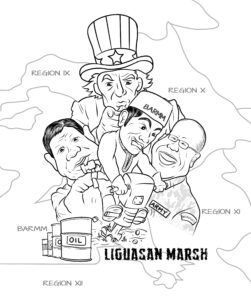Crisis and rivalry in the semiconductor industry

The US and China are now pouring new investments in a race to dominate the semiconductor industry. Presently, both leading imperialist countries do not have enough capacity to produce enough semiconductors and rely on imports from Taiwan and Japan. Aware of growing importance of semiconductors, they are pushing for “insourcing” (opposite of “outsourcing”) to bring semiconductor production within their countries.
China relies heavily on semiconductor imports. Local production covers only 15.7% of the country’s requirements in 2018. In 2020, it imported $350 billion worth of semiconductors, 14.6% higher than in 2019. Sourcing of semiconductors severely affected the smartphone production of Huawei. Due to US pressure, the Taiwan Semiconductor Company or TSMC stopped supplying Huawei of advanced microchips, causing the latter to stop manufacturing its advanced smartphone models.
China declared its Made in China 2025 with declared aim of attaining capacity to produce 70% of required semiconductor supplies. China is anticipated to invest billions upon billions of dollars to subsidize companies to construct new facilities. However, because of US sanctions and its allies, China will face difficulties to achieve its goal of manufacturing advanced microchips (the equipment for the production of which is solely produced by the ASML company of The Netherlands, a US ally).
Meanwhile, the Biden government is pushing to bring semiconductor production within US soil. It has announced plans to allot $50 billion in the form of subsidies, tax incentives, infrastructure building and other investments in the industry. The White House is directly intervening in the name of “rebuilding America.” The bill CHIPS for America Act has been filed before the US congress with the aim of dominating global capacity in the manufacturing of advanced semiconductors.
The big capitalists are now racing to fill the semiconductor shortage which is expected to last up to 2023. There is high demand for microchips leading to increasing revenues for manufacturers. There are now plans to establish 29 new factories: 19 this year and 10 in 2022, with eight each in China and Taiwan, six in America, three in Europe and the Middle East, and two each in Japan and South Korea. Europe aims to cut produce 30% of global semiconductor supply.
Taiwan controls the bulk of semiconductor production and is the principal manufacturer of advanced microchips. Taiwanese semiconductor companies were primarily established by multinational corporations, including the biggest, TMSC, which was established by Philips. There is growing anxiety in the US that China will take over Taiwan. Thus, the US is strengthening its presence around Taiwan to protect US interests and ensure that China will not get hold of advanced technology.
Wringing workers
Because of the rush to fill the shortage, production in semiconductor factories are on high tempo. This is resulting in intensification of labor. In Taiwan and Singapore, factories are on a 24-hour shift despite the dangers posed by the pandemic.
In Taiwan, workers mostly migrants from the Philippines, Indonesia, Malaysia, Thailand and other countries, are being compelled to stay in dormitories inside company compound to enforce a military-style factory “discipline.” These dormitories, where 8-10 workers are packed in every room, have served as vectors for the rapid transmission of Covid-19 infections.
While the core part of semiconductor production using advanced technology are in the capitalist countries, a large part of the manufacturing process are carried out in the “economic zones” of backward countries like the Philippines. This is where parts of the manufacturing process have been outsourced requiring intense labor-power, particularly, assembly, packaging and testing. This is also where parts of the manufacturing process are located where workers are exposed to harmful chemicals banned in western countries.
Semiconductor manufacturing maintains a “clean” image drawn from how workers wear personal protective equipment (PPE) typically seen in hospitals. But the PPEs, in fact, are not for the protection of workers, rather for the equipment they use. Their PPE are not enough to protect them from the chemicals which they directly handle or from the fumes of which they inhale.
Since the 1980s, it is common that majority of workers in these factories are women. Here they exposed and inhale poisonous and carcinogenic chemicals used in production. Different studies have discovered that women workers in semiconductor factories have a higher rate of abortion compared to the general population. Various forms of cancer such as leukemia and breast cancer are prevalent. Studies have also shown high cases of visual impairment or blindness of longtime workers in semiconductor production.
In the face of rivalries of big capitalists to control the semiconductor industry, workers must unite firmly to defend their welfare and interests against intensified exploitation.
(This is the last of a two-part article.)
FIRST PART: Crisis and rivalries in the semiconductor industry
















